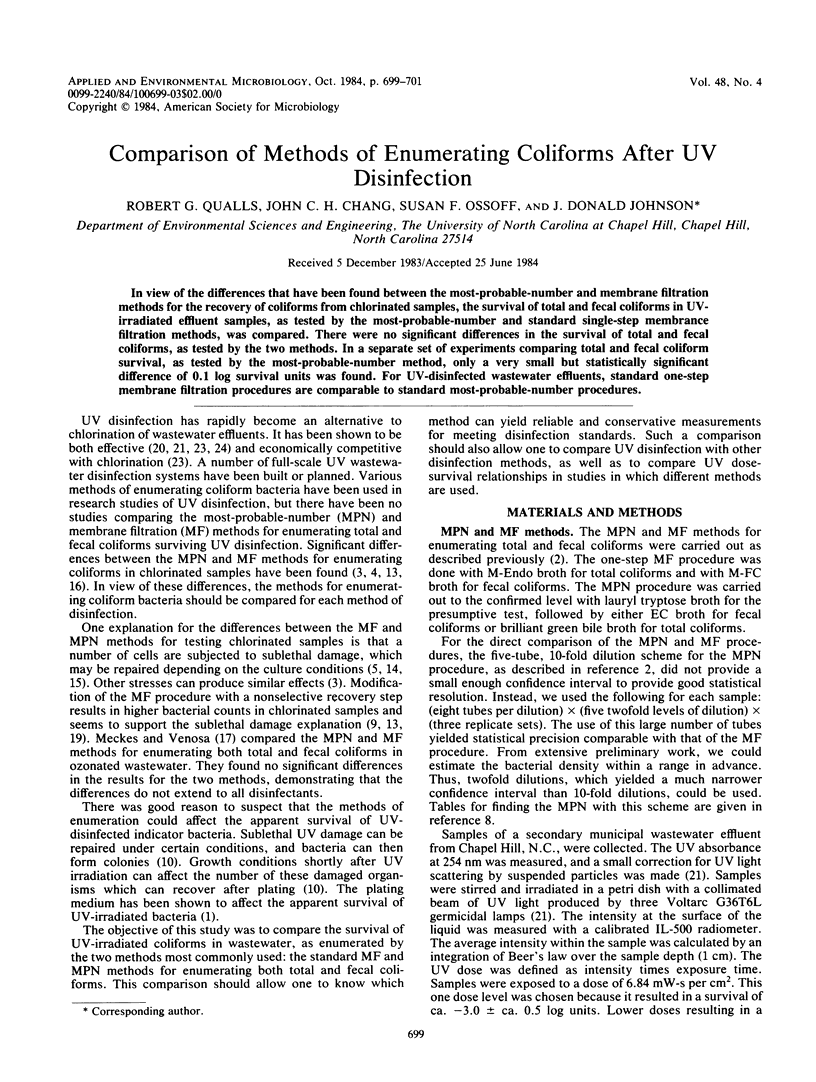Abstract
In view of the differences that have been found between the most-probable-number and membrane filtration methods for the recovery of coliforms from chlorinated samples, the survival of total and fecal coliforms in UV-irradiated effluent samples, as tested by the most-probable-number and standard single-step membrane filtration methods, was compared. There were no significant differences in the survival of total and fecal coliforms, as tested by the two methods. In a separate set of experiments comparing total and fecal coliform survival, as tested by the most-probable-number method, only a very small but statistically significant difference of 0.1 log survival units was found. For UV-disinfected wastewater effluents, standard one-step membrane filtration procedures are comparable to standard most-probable-number procedures.
Full text
PDF


Selected References
These references are in PubMed. This may not be the complete list of references from this article.
- ALPER T., GILLIES N. E. The relationship between growth and survival after irradiation of Escherichia coli strain B and two resistant mutants. J Gen Microbiol. 1960 Feb;22:113–128. doi: 10.1099/00221287-22-1-113. [DOI] [PubMed] [Google Scholar]
- Bissonnette G. K., Jezeski J. J., McFeters G. A., Stuart D. G. Evaluation of recovery methods to detect coliforms in water. Appl Environ Microbiol. 1977 Mar;33(3):590–595. doi: 10.1128/aem.33.3.590-595.1977. [DOI] [PMC free article] [PubMed] [Google Scholar]
- Braswell J. R., Hoadley A. W. Recovery of Escherichia coli from chlorinated secondary sewage. Appl Microbiol. 1974 Aug;28(2):328–329. doi: 10.1128/am.28.2.328-329.1974. [DOI] [PMC free article] [PubMed] [Google Scholar]
- Camper A. K., McFeters G. A. Chlorine injury and the enumeration of waterborne coliform bacteria. Appl Environ Microbiol. 1979 Mar;37(3):633–641. doi: 10.1128/aem.37.3.633-641.1979. [DOI] [PMC free article] [PubMed] [Google Scholar]
- Evans T. M., Waarvick C. E., Seidler R. J., LeChevallier M. W. Failure of the most-probable-number technique to detect coliforms in drinking water and raw water supplies. Appl Environ Microbiol. 1981 Jan;41(1):130–138. doi: 10.1128/aem.41.1.130-138.1981. [DOI] [PMC free article] [PubMed] [Google Scholar]
- Green B. L., Clausen E. M., Litsky W. Two-temperature membrane filter method for enumerating fecal coliform bacteria from chlorinated effluents. Appl Environ Microbiol. 1977 Jun;33(6):1259–1264. doi: 10.1128/aem.33.6.1259-1264.1977. [DOI] [PMC free article] [PubMed] [Google Scholar]
- LeChevallier M. W., Evans T. M., Seidler R. J. Effect of turbidity on chlorination efficiency and bacterial persistence in drinking water. Appl Environ Microbiol. 1981 Jul;42(1):159–167. doi: 10.1128/aem.42.1.159-167.1981. [DOI] [PMC free article] [PubMed] [Google Scholar]
- Lin S. Evaluation of coliform tests for chlorinated secondary effluents. J Water Pollut Control Fed. 1973 Mar;45(1):498–506. [PubMed] [Google Scholar]
- Pagel J. E., Qureshi A. A., Young D. M., Vlassoff L. T. Comparison of four membrane filter methods for fecal coliform enumeration. Appl Environ Microbiol. 1982 Apr;43(4):787–793. doi: 10.1128/aem.43.4.787-793.1982. [DOI] [PMC free article] [PubMed] [Google Scholar]
- Qualls R. G., Johnson J. D. Bioassay and dose measurement in UV disinfection. Appl Environ Microbiol. 1983 Mar;45(3):872–877. doi: 10.1128/aem.45.3.872-877.1983. [DOI] [PMC free article] [PubMed] [Google Scholar]
- Severin B. F. Disinfection of municipal wastewater effluents with ultraviolet light. J Water Pollut Control Fed. 1980 Jul;52(7):2007–2018. [PubMed] [Google Scholar]


